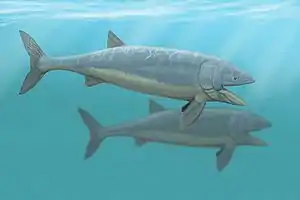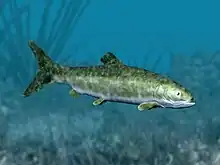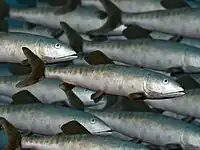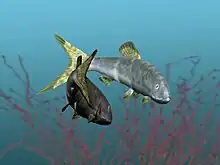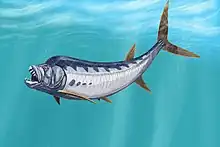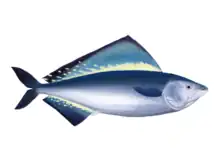| Thrissops Temporal range: | |
|---|---|
 | |
| Thrissops formosus | |
| Scientific classification | |
| Domain: | Eukaryota |
| Kingdom: | Animalia |
| Phylum: | Chordata |
| Class: | Actinopterygii |
| Order: | †Ichthyodectiformes |
| Genus: | †Thrissops Agassiz, 1833 |
Thrissops (from Greek: θρῐ́ξ thrix, 'hair' and Greek: ὄψις ópsis 'look')[1] is an extinct genus of stem-teleost fish from the Jurassic and Cretaceous periods. Its fossils are known from the Solnhofen Limestone,[2] as well as the Kimmeridge Clay.
Thrissops was a fast predatory fish about 60 centimetres (24 in) long, that fed on other bony fish.[3] It had a streamlined body with a deeply cleft tail and only very small pelvic fins. Thrissops was one of the smaller members of the order Ichthyodectiformes, which also included giants like Xiphactinus and Saurodon.[4]
References
- ↑ Roberts, George (1839). An etymological and explanatory dictionary of the terms and language of geology. London: Longman, Orme, Brown, Green, & Longmans. p. 171. Retrieved 31 December 2021.
- ↑ Solnhofen und seine Fossilien: Thrissops Archived 2010-04-29 at the Wayback Machine
- ↑ Orvar Nybelin, "Versuch einer taxonomischen revision der jurassischen Fischgattung Thrissops Agassiz", Nature (1964)
- ↑ Palmer, D., ed. (1999). The Marshall Illustrated Encyclopedia of Dinosaurs and Prehistoric Animals. London: Marshall Editions. p. 39. ISBN 1-84028-152-9.
This article is issued from Wikipedia. The text is licensed under Creative Commons - Attribution - Sharealike. Additional terms may apply for the media files.
